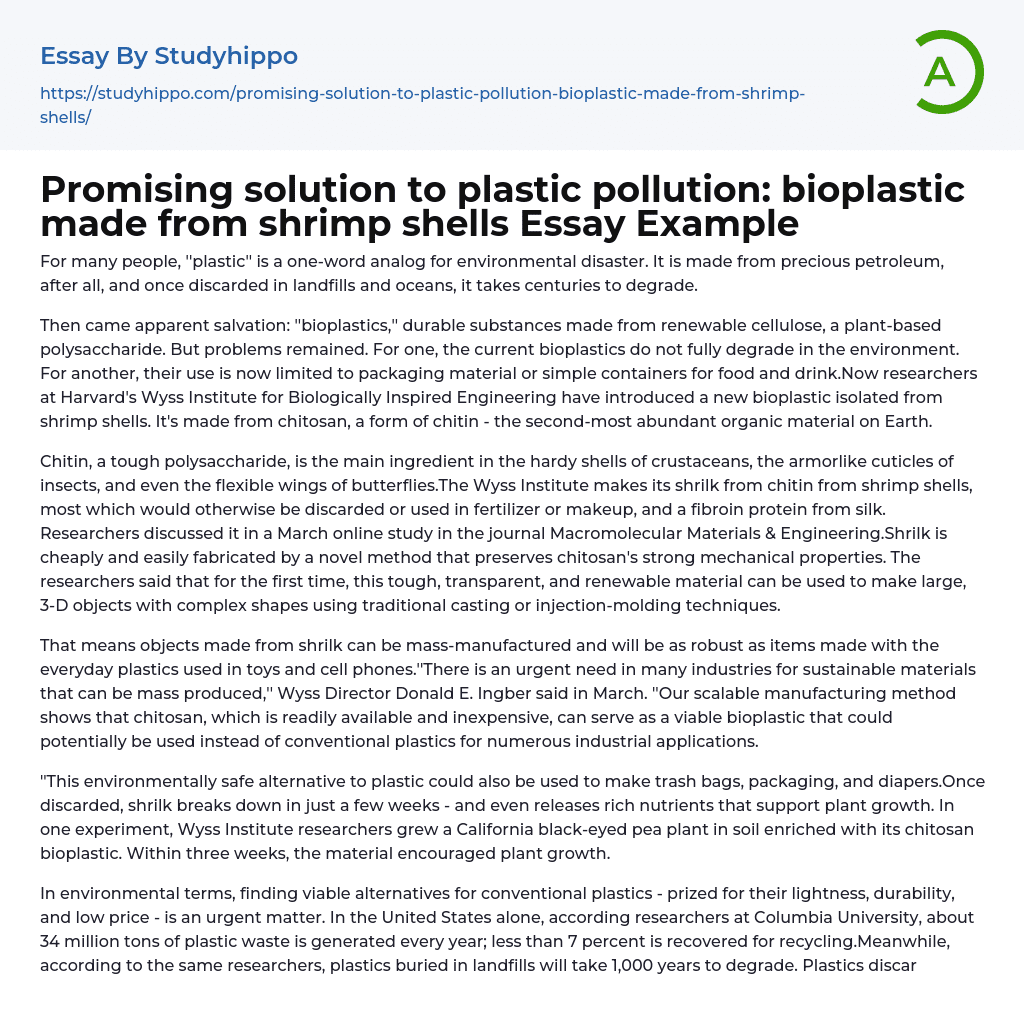

Promising solution to plastic pollution: bioplastic made from shrimp shells Essay Example
The negative impact of plastic on the environment is widely recognized, due to its production from petroleum and its slow rate of degradation in landfills or oceans.
The initial aim of "Bioplastics" was to tackle environmental concerns by utilizing plant-derived polysaccharide cellulose. Despite being perceived as a viable solution, contemporary bioplastics are limited in their usage and are only employed for packaging or rudimentary food and beverage receptacles. Additionally, these plastics do not completely decompose in the environment. However, Harvard's Wyss Institute for Biologically Inspired Engineering has developed a novel form of bioplastic using chitosan, which originates from shrimp shells and overcomes both constraints.
Shrimp shells, traditionally discarded or used in cosmetics and fertilizer production, contain abundant chitin - a tough polysaccharide found in insect cuticles, crustacean shells, and butterfly wings. The Wyss Institut
...e has successfully combined this chitin with fibroin protein from silk to create shrilk, an innovative material discussed in an online study published by researchers in March's Macromolecular Materials & Engineering journal. This method preserves the strong mechanical properties of chitosan while enabling cost-effective production of renewable and transparent shrilk. For the first time ever, conventional casting or injection-molding techniques can be used to produce large 3-D items with intricate shapes using shrilk.
According to Wyss Director Donald E. Ingber, there is a pressing demand in various industries for sustainable materials that can be mass-produced. In March, he stated that shrilk objects can be manufactured on a large scale and have the same robustness as items created with ordinary plastics used in toys and mobile phones. Additionally, he noted that chitosan, an affordable and readily available substance, could serve as a feasible bioplastic
alternative to traditional plastics for multiple industrial purposes thanks to our adaptable manufacturing technique.
With potential applications in creating trash bags, packaging and diapers, Shrilk is an eco-friendly bioplastic that decomposes quickly and releases nutrients that promote plant growth. A study conducted by Wyss Institute revealed that enriching soil with chitosan bioplastic resulted in increased growth of a California black-eyed pea plant within three weeks.
Although conventional plastics are lightweight, durable, and inexpensive, they have a harmful impact on the environment. As a result, there is an urgent demand for alternatives. At Columbia University, researchers discovered that in America alone, over 34 million tons of plastic waste are produced each year with less than 7 percent being recycled. Moreover, it can take up to 1,000 years for plastics buried in landfills to decompose. Additionally, roughly 100 million tons of plastic waste has been dumped into oceans worldwide which poses a danger to sea creatures due to its circulation in vast oceanic gyres.
The Wyss Institute at Harvard is tackling the urgent problem of excessive plastic usage by creating a sustainable substitute. Their encouraging answer involves utilizing chitosan to produce bioplastic. To test their solution, the scientists cultivated a California black-eyed pea plant in soil enriched with their bioplastic and observed an impressive growth spurt within three weeks. For more details on this groundbreaking initiative, watch the video provided below.
- Environment Pollution essays
- Plastic Pollution essays
- Atmosphere essays
- Biodiversity essays
- Coral Reef essays
- Desert essays
- Earth essays
- Ecosystem essays
- Forest essays
- Lake essays
- Natural Environment essays
- Ocean essays
- Oxygen essays
- Rainbow essays
- Sea essays
- Soil essays
- Volcano essays
- Water essays
- Wind essays
- Animal Welfare essays
- Climate Change essays
- Conservation essays
- Global Warming essays
- Plastic essays
- Recycling essays
- Waste Management essays
- Zoo essays
- Air Pollution essays
- Carbon Dioxide essays
- Climate essays
- Deforestation essays
- Ecology essays
- Endangered Species essays
- Environmental Issues essays
- Environmental Protection essays
- flood essays
- Greenhouse Gas essays
- Hurricane essays
- Nature essays
- Pollution essays
- Renewable Energy essays
- Sustainability essays
- Tornado essays
- Traffic essays
- Tsunami essays
- Water Pollution essays



